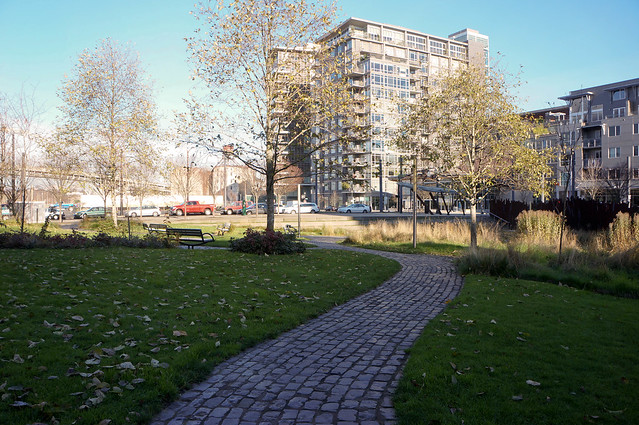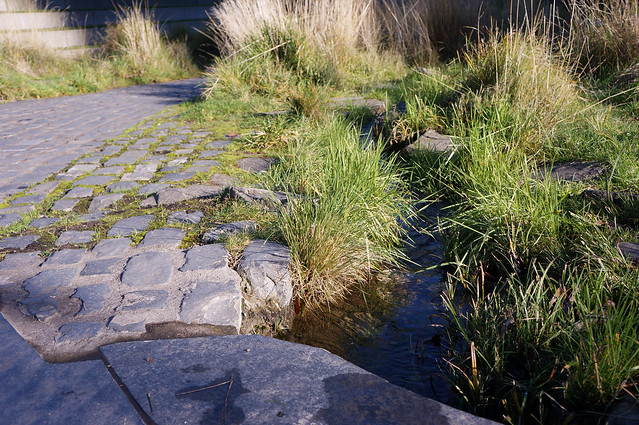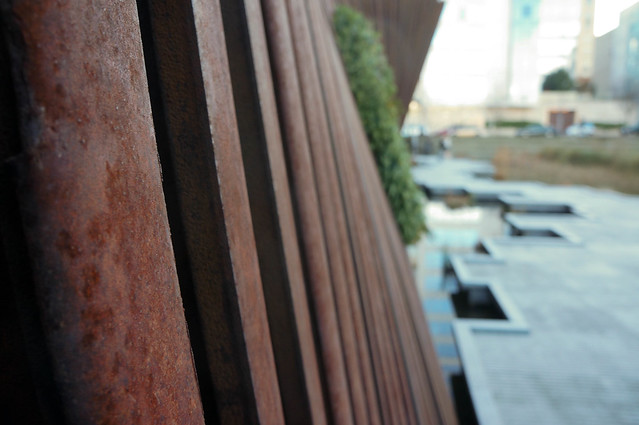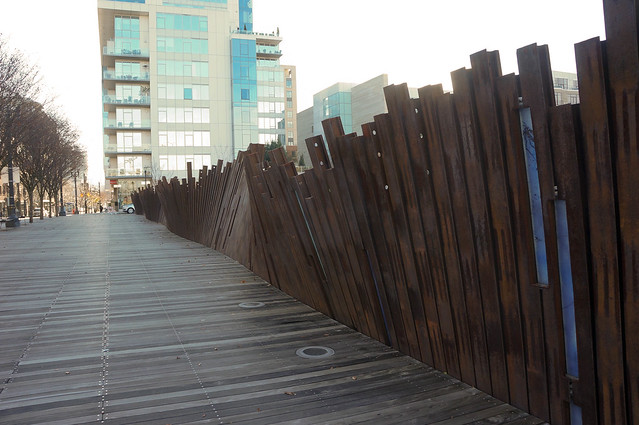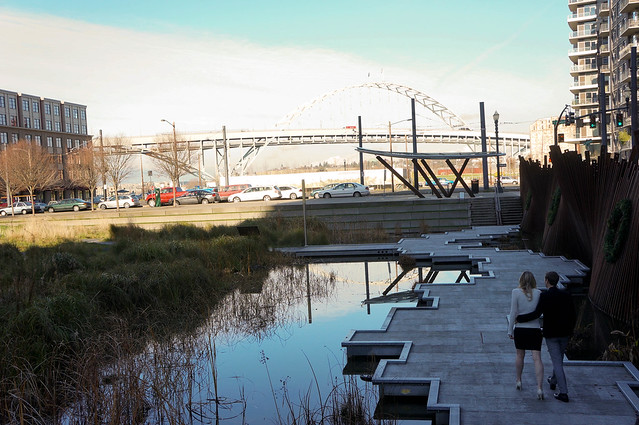
Shared posts
"There’s nothing like eating your own home- grown vegies, and there are heaps of different foods that..."
- 16 Foods That’ll Re-Grow from Kitchen Scraps | Wake Up World
Everything is Different Now, maybe, or not
I asked twitter what counts as “post-9/11” American literature, with or without the “American.” This is what they and I came up with:
- Joseph Conrad, The Secret Agent (1906)
- Don DeLillo, The Names (1982)
- Hanif Kureishi, The Black Album (1996)
- Suheir Hammad, “First Writing Since” (2001)
- Orhan Pamuk, “The Anger of the Damned” (2001)
- Salman Rushdie, “Yes, This is About Islam” (2001)
- Arundhati Roy, “The Algebra of Infinite Justice” (2001)
- Ward Churchill “Some People Push Back: On the Justice of Roosting Chickens” (2001)
- Wells Tower, “Everything Ravaged, Everything Burned” (2002)
- Granta 77 “What We Think of America” (2002)
- Amiri Baraka, “Somebody Blew Up America” (2002)
- Spike Lee, 25th Hour (2002)
- Slavoj Zizek, “Welcome to the Desert of the Real” (2002)
- William Gibson, Pattern Recognition (2003)
- Donald Rumsfeld, occasional poetry. (2003)
- Michael Muhammad Knight, The Taqwacores (2003)
- Tom Junod, “The Falling Man” (2003)
- David Foster Wallace, “The Suffering Channel” (2004)
- The 9/11 Commission Report (2004)
- Art Spiegelman, In the Shadow of No Towers (2004)
- Tony Kushner, Only We Who Guard The Mystery Shall Be Unhappy (2004)
- Battlestar Galactica (2004-8)
- Brian K. Vaughan, Ex Machina (2004-2010)
- Christopher Nolan, Batman Begins (2005)
- Wes Craven, Red Eye (2005)
- Interrogation Log of Detainee 063 at Guantanamo Bay (2005)
- Jonathan Safran Foer, Extremely Loud and Incredibly Close (2005)
- Rattawut Lapcharoensap, Sightseeing (2005)
- Frédéric Beigbeder, Windows on the World (2005)
- Juliana Spahr, This Connection of Everyone With Lungs (2005)
- Khaled Hosseini, The Kite Runner (2005)
- Erik Saar and Viveca Novak, Inside The Wire: Inside the Wire, A Military Intelligence Soldier’s Eyewitness Account of Life at Guantanamo (2005)
- Ken Kalfus, A Disorder Peculiar to the Country (2006)
- Alfonso Cuaron, Children of Men (2006)
- Richard Powers, The Echo Maker (2006)
- Jess Walter, The Zero (2006)
- Jonathan Raban, Surveillance (2006)
- Max Brooks, World War Z: An Oral History of the Zombie War (2006)
- Laird Hunt, The Exquisite (2006)
- Nell Freudenberger, The Dissident (2006)
- Ashis Nandy, “The Other 9/11” (2006)
- John Updike, Terrorist (2006)
- Claire Messud, The Emperor’s Children (2006)
- David Hare, Stuff Happens (2006)
- Don DeLillo, Falling Man (2007)
- Juliana Spahr, The Transformation (2007)
- Denis Johnson, Tree of Smoke (2007)
- Mohsin Hamid, The Reluctant Fundamentalist (2007)
- Paul Haggis, In the Valley of Elah (2007)
- Sinan Antoon, I’jaam (2007)
- William Gibson, Spook Country (2007)
- Phillip Roth, Exit Ghost (2007)
- Verso, War With No End (2007)
- Pankaj Mishra, “The End of Innocence” (2007)
- Yasmina Khadra, The Swallows of Kabul (2008)
- Christopher Nolan, The Dark Knight (2008)
- Martin Amis, The Second Plane (2008)
- Kathryn Bigelow, The Hurt Locker (2008)
- James Marsh, Man on Wire (2008)
- Coen Brothers, The, Burn After Reading (2008)
- Chris Adrian, A Better Angel (2008)
- Nadeem Aslam, Wasted Vigil (2008)
- Harold & Kumar Escape from Guantanamo Bay (2008)
- Joseph O’Neill Netherland (2008)
- Aleksandar Hemon, The Lazarus Project (2008)
- Neill Blomkamp, District 9 (2009)
- Armando Iannucci, In the Loop (2009)
- Jonathan Lethem, Chronic City (2009)
- Chuck Palahniuk, Pygmy (2009)
- David Finkel, The Good Soldiers (2009)
- Colum McCann, Let the Great World Spin (2009)
- Amitava Kumar, A Foreigner Carrying in the Crook of His Arm a Tiny Bomb (2010)
- Rachel Zolf, Neighbour Procedure (2010)
- George W. Bush, Decision Points (2010)
- William Gibson, Zero History (2010)
- Lorraine Adams, Harbor (2010)
- Lorraine Adams, The Room and the Chair (2011)
- Amy Waldman, The Submission (2011)
- Lorrie Moore, A Gate at the Stairs (2009)
- Hari Kunzru, Gods Without Men (2011)
- Lavie Tidhar, Osama (2011)
- Edmund Caldwell, Human Wishes/Enemy Combatant (2011)
- Daisy Rockwell, Little Book of Terror (2011)
- Lavie Tidhar, Osama (2011)
- Claudia Rankine, Don’t Let Me Be Lonely: An American Lyric (2011)
- Jarett Kobek, ATTA (2011)
- Kathryn Cramer, “Am I Free To Go?” (2012)
- Sam Thompson, Communion Town (2012)
- Kathryn Bigelow, Zero Dark Thirty (2012)
- Poetry of the Taliban (2012)
- Tabish Khair, How to Fight Islamist Terror from the Missionary Position (2012)
- Rowan Ricardo Phillips, The Ground: Poems (2012)
- Teju Cole, Open City (2012)
- Azadeh Moaveni, Lipstick Jihad: A Memoir of Growing up Iranian in America and American in Iran (2012)
Emergency Shelter / Carter Williamson Architects

Architects: Carter Williamson Architects
Architect In Charge: Shaun Carter
Builder: Go-Steel
Area: 37.5 sqm
Year: 2012
Photographs: Brett Boardman

In a world increasingly challenged by both man-made and natural disasters, the Shelter has been designed as a sustainable housing prototype that can be configured to suit almost any climate or orientation and can be readily and cheaply transported to diverse and remote locations around the globe.

Arriving flat-packed, the Shelter can be assembled quickly and has the potential to make a significant difference when applied to a range of medium to long-term housing solutions, it could also provide immediate solutions to industry as it moves to frontier locations. Most importantly, by providing refuge and security for families and communities in crisis, the Shelter can give back to societies in need everywhere.

Beyond emergency relief, the Shelter is known as Pavilion, a flexible module of space that could be used as a holiday house, a remote research laboratory, even mining accommodation; whatever can be conceived of in 37.5 sqm.
































Emergency Shelter / Carter Williamson Architects originally appeared on ArchDaily, the most visited architecture website on 14 Jan 2013.
send to Twitter | Share on Facebook | What do you think about this?
Storm Cottage / Fearon Hay Architects

Architects: Fearon Hay Architects
Location: Great Barrier Island, Auckland, New Zealand
Interiors Collaborator: Penny Hay
Area: 100 sqm
Year: 2012
Photographs: Patrick Reynolds

Located on the east coast of Great Barrier Island – a black rough sawn timber box sits looking north to the sea.
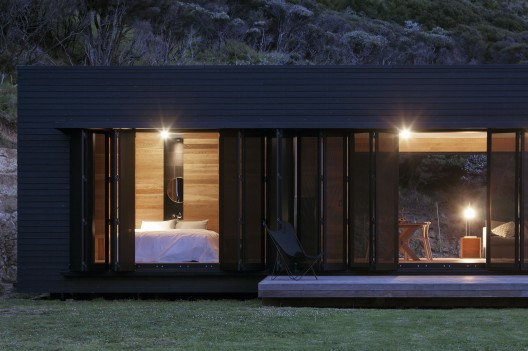
The dark exterior palette is completed with a layer of perforated metal screens. This operable layer allows the moderation of light / air and protection both when occupied and alone. Internally walls and floors are clad with oiled oak boards that provide a warm counter to its robust exterior.
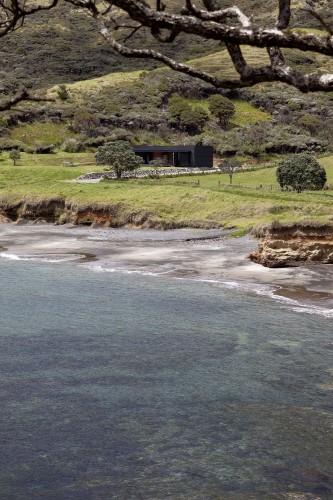
The programme provides for a pair of symmetrical bedrooms and ensuites set about a central living space. Care has been made to limit the scale of the building and maintain a sense of ‘cottage’. The building is off the grid, powered by solar panels independent systems for water collection and treatment.

This is a retreat that provides shelter, warmth and comfort to engage with the wilderness and isolation of the remote setting.














Storm Cottage / Fearon Hay Architects originally appeared on ArchDaily, the most visited architecture website on 14 Jan 2013.
send to Twitter | Share on Facebook | What do you think about this?
The only person of color to score a win at last night’s Golden Globe Awards was probably also the biggest upset: Don Cheadle won Best Actor in a Comedy Series for his starring turn in House Of Lies, over nominees from the likes of 30 Rock, The Big Bang Theory and critical darling Louis C.K., among others.
He also handled the awkward task of following Quentin Tarantino’s in addressing the press corps backstage, in which Tarantino dropped an N-bomb to defend it appearing so much in Django Unchained, which netted him the Best Screenplay (Motion Picture) award.
Buffalo Chicken Pull Apart Bread
billtronLet's make this.
Prep time
40 mins
Cook time
40 mins
Total time
1 hour 20 mins Buffalo Chicken Pull Apart Bread will put any other loaf to shame at your Super Bowl party!
Author: Morgan
Recipe type: Bread
Ingredients
3 tubes Pillsbury Recipe Creations Seamless Dough
1½ cups Crock Pot Buffalo Chicken (click to open recipe in a new tab)
½ cup colby-jack cheese, shredded
⅓ cup scallions, chopped
Nonstick cooking spray
Directions
Preheat the oven to 350 degrees F.
Unroll each tube of Pillsbury dough and cut each into 8 even rectangles (slicing once lengthwise and three times along the width).
Using a spoon, spread a thin layer the Crock Pot Buffalo Chicken on each rectangle. Don’t overdo it, or the bread will not cook on the inside.
Sprinkle each rectangle with cheese and scallions.
Use a spatula to stack the rectangles in fours.
Spray a mini loaf pan with nonstick cooking spray and prop it up vertically by placing something behind it. I used a can of soup.
Stack all of the buffalo chicken rectangles into your baking dish. Push down lightly on the tops of the stacks as you add more.
Sit the pan horizontally (the way it should be, normally) and sprinkle with extra cheese and scallions, if you’d like.
Bake in the oven for about 40 minutes, or until top begins to brown.
Let cool for 20 minutes in the pan before removing and serving.
Notes Start the Crock Pot Buffalo Chicken about a day ahead of time.
"No prosecution of war criminals, torturers and mass murderers; no prosecution of those that declare..."
- Carmen Ortiz Did Not Act Alone in Hounding Aaron Swartz To His Death « Samir Chopra
"The television series ‘24’ has been a television phenomenon which over seven series has spawned a..."
- Trust US Justice: ‘24’, Popular Culture and the Law by Desmond Manderson :: SSRN
kgoldschmitt: The forgotten musical protest against the First...
The forgotten musical protest against the First Gulf War. Music & Social Protest at the height of MTV.
Tanner Springs Park | Portland, OR
billtron@lg+-- #PDX
Built atop a formerly contaminated industrial site, Tanner Springs Park is considered "an experiment in sustainable park design and management." This innovative park is located in the Pearl District of northwest Portland, an area that was once a wetland and a lake. As the population grew in the late 19th century, however, the wetland and lake were filled in, Tanner Creek was rerouted through underground pipes and the land built over with warehouses and residences. Today, the design of Tanner Springs Park represents a desire to reconnect Portland with its ecological history; the park sits about 20 feet above the former lake surface.
Initial planning efforts for the Pearl District in the 1990s included early plans for a network of open spaces. After the opening of Jamison Square, which was the first of the open spaces to be developed, the planning for Tanner Springs Park began in early 2003. Atelier Dreiseitl, a renowned German design firm, and GreenWorks, P.C., an award-winning, local landscape architecture firm, were selected to design the park in conjunction with community involvement.
Site Plan. Image Credit: greenbuildingbrain.org
The final design reconnects the neighborhood with the pre-industrial wetlands, not only by recreating the historical landscapes, but by showcasing the closed-loop water system as well. Sloping downwards from west to east, the west end of the park starts with an Oak savannah prairie followed by a native grassland, the wetland, and finally a pond at the eastern end.
From the park sign:
"All the rainwater that falls within the curb-line of the park is collected and treated within the park--a first for a Portland park. Rather than channeling the stormwater to storm drains in the street, all of it is filtered within the park. an ultra violet light system is used, as well as natural soil filtration as the water runs "downstream" through the runnels. No chemicals are used to treat the water in this closed system."
A Rainwater Pavilion was also added to channel captured rainwater back into the park's pond and streams.
Tanner Springs Park should also be noted for its strong representation of Portland's prior industrial landscape through the use of various materials. The signature art installation at the east end of the park consists of a sloped and staggered wall of 99 vertical rail tracks, used in the 19th century Portland rail yards. This wall of rusting reddish brown rail tracks are interspersed with blue stained glass panels with images of insects--"a merging of man-made and natural references." The basalt Belgian blocks that pave the park walkways are historically significant as well. The material originally served as ballast on ships traveling up the Columbia River and later cobbled the streets of Portland.
Fun Fact: Tanner Springs Park was featured as 'Lipsy Park' in an episode of Portlandia, a satirical television series set in Portland, OR.
About the Journey:
Hi! My name is Lucy Wang and I'm a recent landscape architecture grad from the University of Maryland. I'm currently traveling the U.S. (and parts of Canada) by public transportation for the next several months in search of great, publicly-accessible landscape architecture sites, as well as landscape architecture firms and universities. I'll be sharing some of my favorite finds on Land8 along the way. For more information, check out my profile. As always, feel free to leave a comment below!
Where I've been:
California Academy of Sciences Green Roof, San Francisco
Gary Comer Youth Center Green Roof, Chicago
Sheds in medieval illuminated manuscripts

The British Library has not only put online its fantastic Catalogue of Illuminated Manuscripts , it has also effectively put them in the Public Domain, even though they are technically still in copyright in the UK until 2040. There are obviously lots of marvellous images there - in fact 35,661 of them from 4,231 different manuscripts - but with shuddering predictability we've focused on the search term 'shed'. Pictured above and below are a couple of results from Petrus de Crescentiis's Ruralia commoda in a French translation attributed to Jean Corbechon, dating from the Netherlands in the late 15th century. Above is a man winnowing wheat, below the author in an orchard (might he have shedworked in that shed?).

----------------------------------------------------------------------------
 Wednesday posts are sponsored by The Stable Company®, the UK's premier supplier of garden offices and garden rooms. Click here
Wednesday posts are sponsored by The Stable Company®, the UK's premier supplier of garden offices and garden rooms. Click here
Sinningia ‘Kevin Garnet’ Update
Quote about thinking
[There is a] rather widespread belief that thinking must interfere with doing. … [But] both ordinary people and professional practitioners often think about what they are doing, sometimes even while doing it. –Donald Schön
Seen & Noted Part 2: Gardens Take a Backseat
Entire Backyards are being devoted to Ponds:
Garden ponds have been popular for some time. This past summer however, I was amazed to see how many homeowners had decided to devote almost their entire backyard to a pond.
I am going to show you just a couple of examples, but I saw more than a few of these large scale water features in 2012.
 Hamilton, Ontario. Pond by Clearwater Pond
Hamilton, Ontario. Pond by Clearwater Pond I am not sure my picture gives you an accurate enough sense of the sheer expanse of this pond.
Trust me, it was enormous!
Save for a small deck that framed the pond like a crescent moon, this sizeable suburban plot was almost entirely under water.

 A flagstone path leads to a gazebo at one corner of the property. A gang plank leads from the gazebo out to a tiny island near the center of the pond.
A flagstone path leads to a gazebo at one corner of the property. A gang plank leads from the gazebo out to a tiny island near the center of the pond. Here is second example:
 Georgetown, Ontario. Pond also by Clearwater Ponds.
Georgetown, Ontario. Pond also by Clearwater Ponds. This is the view looking down from the upper deck of the home into the backyard. A series of streams and waterfalls feed a large pond located just off the back deck.
 Waterfall detail
Waterfall detail  Looking back at the house.
Looking back at the house.  The view at ground level.
The view at ground level. 
Talking with the homeowners, I think it was the sense of being at the cottage, without the long commute, that made them want to devote so much of their property to a pond. The sound of water tumbling down a waterfall also has a pleasant way of drowning out the local traffic noises.
The backyard becomes a place of private retreat and a sanctuary from their busy lives.

Darting fish...

The summer serenade of mating frogs...

and beautiful waterlilies.
I can see the appeal of these large backyard ponds.
 Flowers, trees and shrubs are incorporated, but they take on more of a supporting role.
Flowers, trees and shrubs are incorporated, but they take on more of a supporting role. So what do you think?
Could you ever see having a large water feature like this in your backyard?
My time is short today and so I will put up the name of the winners for the book draws on Sunday.
Shed Sunday
A Cartoonish, Funky Art Shed/Shack/Guest House by Derek 'Deek" Diedricksen -------------------------------------------------------------------------------
 Sunday posts are sponsored by Garden Spaces, suppliers of contemporary garden buildings, offices, gyms and studios, many of which do not require planning
Sunday posts are sponsored by Garden Spaces, suppliers of contemporary garden buildings, offices, gyms and studios, many of which do not require planning
Penta-Hex Bottle Opener

So, without looking at the title, what do you think this is? A weapon? A tool? Perhaps both? It’s a small bottle opener, and one with a hexagonal opening and faceted polygonal silhouette at that. Designed by Bec Brittain (she has worked with Lindsey Adelman, who you’ve heard of by now, and has her own excellent lighting designs). For an extra $5, Ms. Brittain will add a monogram with up to 7 characters, including any combination of letters, numbers, a period, and a heart. Talk about an excellent gift for anyone with an appreciation of geometry- it’s a no brainer.
Materials: Water-jet cut, hand-polished brass.
Measurements: Approximately 3.5″ x 2″
Finn Style and Sound: Gradient Speakers — Snapshots from CES 2013
billtronDoes this mean that the Vandersteen speakers don't work?
 These white/wood speakers from Finnish maker Gradient/model 5 sounded full and detailed with a clean Scandinavian look. More
These white/wood speakers from Finnish maker Gradient/model 5 sounded full and detailed with a clean Scandinavian look. More
 |
 |
Blind Musical Flames—Flames Morale
Side A
High Morale
Tifi Sidom
Diamond
Mantaraty
Side B
Big Berin
Poda Poda
Seda Seda
Positive greetings from essential Sierra Leonean sight-impaired super-group Blind Musical Flames. Welcome to 2013. We're starting light for now here at Awesome Tapes From Africa, deeper heavies to come. Hope you like simple pleasures, some dancing and a little bit of reggae.
http://daniv.blogspot.com/2013/01/milhauds-silent-partners-instituto.html
Milhaud’s silent partners
Instituto Moreira Salles published last month the book O boi no telhado—Darius Milhaud e a música brasileira no modernismo francês, organized by the musicologist Manoel Aranha Corrêa do Lago.
Along with the book, IMS made available a hotsite with recordings of the tunes quoted in Le Boeuf sur le Toit in streaming format and scans of their original scores.
Among the scholarly chapters in the book is my modest contribution, “Parceiros em surdina.” The English version of this chapter, titled “Milhaud’s silent partners,” may be read on my website as part of the Boeuf Chronicles series.
_________________________The inspiring heroism of Aaron Swartz | Glenn Greenwald | Comment is free | guardian.co.uk
At the age of 14, Swartz played a key role in developing the RSS software that is still widely used to enable people to manage what they read on the internet. As a teenager, he also played a vital role in the creation of Reddit, the wildly popular social networking news site. When Conde Nast purchased Reddit, Swartz received a substantial sum of money at a very young age. He became something of a legend in the internet and programming world before he was 18. His path to internet mogul status and the great riches it entails was clear, easy and virtually guaranteed: a path which so many other young internet entrepreneurs have found irresistible, monomaniacally devoting themselves to making more and more money long after they have more than they could ever hope to spend.
But rather obviously, Swartz had little interest in devoting his life to his own material enrichment, despite how easy it would have been for him. As Lessig wrote: "Aaron had literally done nothing in his life 'to make money' . . . Aaron was always and only working for (at least his conception of) the public good."
Specifically, he committed himself to the causes in which he so passionately believed: internet freedom, civil liberties, making information and knowledge as available as possible. Here he is in his May, 2012 keynote address at the Freedom To Connect conference discussing the role he played in stopping SOPA, the movie-industry-demanded legislation that would have vested the government with dangerous censorship powers over the internet.
Critically, Swartz didn't commit himself to these causes merely by talking about them or advocating for them. He repeatedly sacrificed his own interests, even his liberty, in order to defend these values and challenge and subvert the most powerful factions that were their enemies. That's what makes him, in my view, so consummately heroic.
In 2008, Swartz targeted Pacer, the online service that provides access to court documents for a per-page fee. What offended Swartz and others was that people were forced to pay for access to public court documents that were created at public expense. Along with a friend, Swartz created a program to download millions of those documents and then, as Doctorow wrote, "spent a small fortune fetching a titanic amount of data and putting it into the public domain." For that act of civil disobedience, he was investigated and harassed by the FBI, but never charged.
"On Friday, a highly educated, very smart colleague at The New Yorker explained her decision to..."
- For God’s Sake, Go Get a Flu Shot : The New Yorker
She's watching The Notebook
Aimee just said “This isn’t credible because he doesn’t have a giant boner right now.”
Korean Drama sign, Koreatown, Bloor Street West, Toronto, Ontario, Canada
gruntzooki posted a photo:
Downton Files (by craniumplanetarium)
billtronThis one was done by Beca, the lead character in Pitch Perfect.





